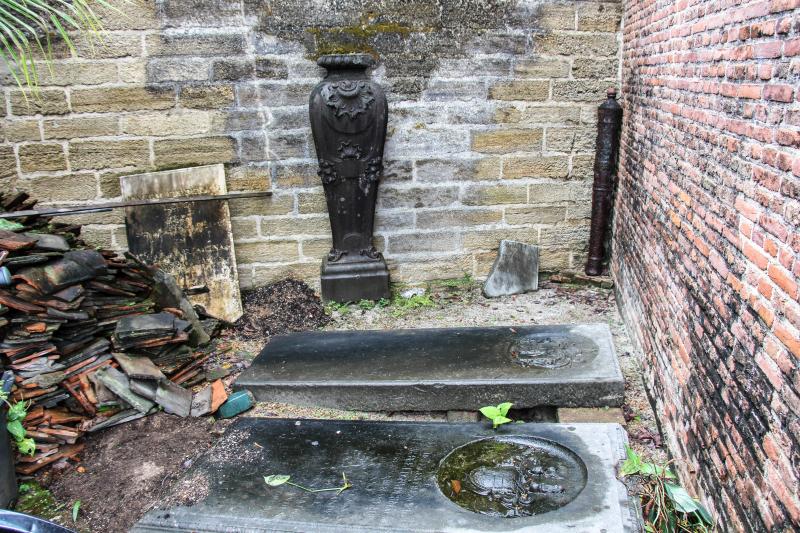The first Dutch burials in Paramaribo
The death rate among Europeans was high in the tropics. The Briton Stedman was employed by the Republic as captain of a corps of volunteers sent to Suriname to quell an uprising of runaway slaves. In 1773 he was in Paramaribo and wrote the following:
Op deezen tijd woedden ‘er veele ziekten onder ons scheepsvolk; bijna elken dag wierden ‘er viif of zes matroozen van de koopvaardij-schepen begraaven. Het lot van deeze soort van mensen is in dit land over het algemeen zeer slegt; […] Zij stillen hunnen honger met enige bananen en pisangs, eeten oranjen en drinken water, hetgeen hen welhaast van alle kwaad verlost, door hen naar de eeuwigheid te zenden. Duizenden worden op deeze wijze in het graf gestort, die, volgens den gewoonen loop hunnes levens, nog veele jaaren zouden hebben kunnen tellen. [1]
(Translated from the Dutch edition of 1799: At this time, "many diseases were raging among our ship people; almost every day "there were five or six sailors of the merchant ships buried. The fate of this kind of people is generally very poor in this country; … They satisfy their hunger with bananas and pisangs, and eat oranges, and drink water, which almost saves them from all evil, sending them to eternity. Thousands are thrown into the grave in this way, who, according to the usual course of their lives, could have numbered many more years.)
The junior officers and other military personnel were initially buried in the military cemetery at Fort Zeelandia and later in the soldier and sailor cemetery on the “savaane”. The first Governor-Generals, Commanders and high-ranking officers were buried in the so-called stone inner fortress. Although their living conditions were much better than those of the ordinary working people, they, like them, did not escape the scourge of tropical diseases. Stedman:
Onderstuschen woedden de ziekten meer en meer onder onze soldaten, die aanmerklijk begonnen te verminderen. Den een en twintigsten Mey stierf ook weder een van onze officieren, wiens begraavenis in het fort Zeelandia, daar alle officieren begraven en alle gevangene bewaard worden, ik bijwoonde. Hier zag ik de gevangene rebellen en andere Negers, onder het gekletter van hun boeijen, Pisangs en Yams op de grafsteden der verstorven braaden; ik meende een aantal helsche geesten te zien, die de zielen van hunnen Europische vervolgers pijnigden. [2]
(Translated from the Dutch edition of 1799: Meanwhile, illnesses raged more and more among our soldiers, and they were beginning to diminish considerably. On the twenty-first of May, one of our officers also died, whose burial I attended in Fort Zeelandia, where all officers are buried and all prisoners are kept. Here I saw the captive rebels and other Negroes, with the clatter of their shackles, roasting Pisangs and Yams on the tombs of dead; I thought I saw some hellish spirits tormenting the souls of their European persecutors)
Although the cemeteries of Fort Zeelandia were probably in use for more than 132 years and more than two hundred people were buried, what happened to both cemeteries is a great mystery. What is special is that they are not indicated on any map of Paramaribo or even of the fort. For the inner cemetery, there is only one option, the small inner fort courtyard. Governor Cornelis Aerssen van Sommelsdijck was buried here, who was shot dead in 1688 by mutinous soldiers. He would later have been reburied in Sommelsdijk in the Netherlands in the family crypt. Archival research shows that after 1799 there were no more burials in or near Fort Zeelandia.[3]
 Fort Zeelandia (photo René ten Dam, 2017)
Fort Zeelandia (photo René ten Dam, 2017)
Tangible evidence of both cemeteries remains limited to a number of tombstones that were found in 1954 during the demolition of the old military bakery. Some skeletal parts were also found. [4]
Notes
[1] Stedman, Reize in de binnenlanden van Suriname (1799), pag. 76
[2] Stedman, pag. 83
[3] Research Stephen Fokké.
[4] Fokké, Stephen. ‘Het mysterie rond de verdwenen begraafplaatsen van Fort Zeelandia; voorlopige onderzoeksresultaten’ in: OSO Tijdschrift voor Surinamistiek en het Caraïbisch gebied (2016), pag. 55
Header: William Blake after John Gabriel Stedman Narrative of a Five Years, detail (public domain)
- Last updated on .


